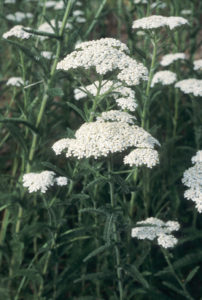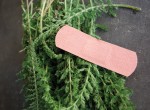Yarrow
SUNFLOWER FAMILY
Yarrow Achillea millefolium
Habitat & Elevation Meadows and open areas below 11,600′
Collection Leaf: spring; Flower, Root: summer
Indigenous Names Mountain Maidu wislam buku*, wislamjo; Nisenan batiwene
![]()
Yarrow Achillea millefolium
Plant type Herbaceous perennial
Size 3″ – 3’x6″ – 3′
Light Full sun to partial shade
Water Drought tolerant to moderate
Zone 2 to 10
Native to the western United States, this robust semi-evergreen perennial will spread aggressively in ideal conditions by underground runners to form dense colonies. Its size varies, from just a few inches to 3′, depending on growing conditions such as soil fertility, sun exposure and irrigation. Fern-like foliage is medium to dark green and finely divided. White, flat-topped flower clusters appear on 2′ – 3′ stems in early summer. Removing spent blooms will stretch the flowering season into fall. The flowers attract butterflies, bees and birds.
Although Yarrow prefers full sun and minimal water, it will tolerate variable conditions including dappled shade, regular garden water and winter flooding. It is drought-tolerant once established but periodic irrigation will produce a more lush appearance.[41]
There are many cultivars of Yarrow that are easy, beautiful and useful plants in the landscape. However, Achillea millefolium should be used very carefully in any situation where its aggressiveness will make it an unwelcome intruder, such as in a manicured perennial border. It is an ideal substitute for turf in a lawn situation where it can spread freely. It tolerates light foot traffic, is soft to the touch, and can be mowed in spring to prevent summer blooms. It can also be used to stabilize slopes or in a meadow garden mixed with other natives such as Blue-eyed Grass (Sisyrinchium bellum) and Purple Needle Grass (Nassella pulchra).[18]
Many cultivars with less aggressive habits and varied flowers and foliage are available, such as ‘Calistoga’ with gray foliage and bright white flowers, ‘Lavender Beauty’ with deep lavender-pink flowers, ‘Paprika’ with rusty-red flowers, and ‘Island Pink’ with dark green foliage and deep pink flowers.[18]
![]()
Yarrow Ale *Makes 5 gallons. Ready to drink in 3 weeks.
- Collect leaves in spring; flowers in summer.
- 8 quart pot
- 5 gallon pot
- 6 gallon tub with airlock (primary fermentation device)
- Iodine (for sterilizing)
- Candy thermometer
- Flip top bottles (or beer bottles, caps and capping tool)
- 4′ of ½” transparent siphon hose
- 6 oz Yarrow leaves and flowers (dried or fresh)
- 6 lbs amber liquid malt
- 1 packet ale yeast
- 1¼ cups sugar
METHOD
- In a 5 gallon pot, heat 4 gallons of water to 150o. Test temperature using a candy thermometer.
- Add malt and stir periodically for 90 minutes.
- In 8 quart pot, bring 1 gallon of water to a boil and then turn off heat. Add the Yarrow and cover immediately. Let cool for 10 minutes or more.
- Using a small amount of iodine, sterilize primary fermentation device.
- Mix ingredients from both pots into primary fermentation device and let cool to 70o.
- Store in 65 – 75o location out of sunlight for 10 – 15 days or until bubbling has completely stopped.
- Add 1½ cups sugar to ale and stir until dissolved. Be careful to use the exact amount to prevent exploding bottles!
- Sterilize beer bottles with soapy water followed by an iodine rinse.
- Fill bottles using siphon hose leaving a 1″ – 2″ air space in each bottle. Avoid pulling up the old yeast, by placing the siphon hose off the bottom of the tub.
- Cap bottles and store in a cool place. Wait 3 weeks and enjoy.[48]
Yarrow Leaf Salad
- Collect young leaves in spring
METHOD
- Chop finely and use raw or sauté for several minutes.
- Serve with seasonal salad greens.
TIP Collect the young leaves and stalks before flowers appear.[7]
![]()
Colds, Coughs and Sore Throats
Use fresh or dried Yarrow flowers for fevers and colds. Make into a tea by steeping flowers (approximately 1 – 2 g) in hot water for 10-15 minutes or take as a tincture, 3 times daily. Make into a tincture by soaking flowers in alcohol, 1 part flowers to 5 parts alcohol (1:5) and shaking daily for a month. Strain into dropper bottles.[52] Note: Yarrow was used extensively for colds by the Micmac, Malecite and Maidu Indians as well as being listed as a fever and cold treatment in The British Herbal Compendium.[48, 52] Its recorded use dates back 60,000 years as it was found, along with other herbs, in the grave of a Neanderthal man. Caution Do not use during pregnancy.[59]
Hair Support
Crush Yarrow flowers and use the juice externally as a treatment for hair loss.[48]
Stomach Disorders
Make a tea by steeping flowers (approximately 1 – 2 g) in hot water for 10 – 15 minutes and drink between meals or take as a tincture 3 times daily. Make into a tincture by soaking 1 part flowers to 5 parts alcohol (1:5) and shaking daily for a month. Strain into dropper bottles.[52]
CAUTION Do not use during pregnancy.[59]
NOTE The German Commission E and the German Standard License approved the use of Yarrow for mild stomach ailments and loss of appetite.
Strength
Make a tea from dried leaves and flowers for low energy.[48]
CAUTION Do not use during pregnancy.[59]
Wounds
Use fresh or powdered dried leaves externally to stop bleeding.[48, 52]
NOTE Yarrow is often referred to as a natural band-aid due to its effective use for this purpose.
Indigenous Use
The Nisenan and Northeastern Maidu drank a tea made from the leaves for fever. The Northeastern Maidu also mashed the leaves and applied to wounds to prevent infection.






